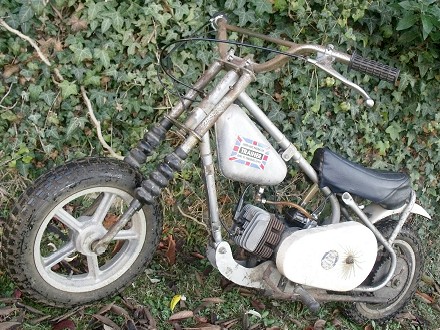
We’ve produced a couple of articles in the past, specifically on children’s garden bikes, and both of these featured four machines. We covered a couple more ‘militarised style’ mini-bikes in Return of the Moped Army in January 2018, but we’ve also accumulated a few other ‘civilian’ styled mini-machine tests over the subsequent years, so maybe it’s time for another mini-bike quadruple feature.
This article initially picks up as a successive chapter to our first Round in Circles mini-bike feature of October 2009.
We were particularly fortunate to have this exceptionally original SIM-50 Mark 3 come our way toward the end of December 2018, as it passed though the workshops for restoration.
Built by the Woodhouse Cornish Company of Bury St. Edmunds, our SIM’s original owners didn’t seem to have given it hardly any use, and the bike was bought by its second owner in the early 1980s for his sons to ride, but again apparently received little use, and was cast aside until 2018. An initial effort by the workshops successfully got the engine working after standing for 30+ years, so the bike returned for extensive restoration and service in time to be ready as a present for Christmas! It seems these mini-bikes may often be passed down respective generations, and this SIM was now moving down to the grandchildren.
Our last Mark 3 in the main article had been acquired with no wheels, with other missing and damaged parts, and subsequently received much improvisation to get it working again, so wasn’t a particularly representative example, but was all we could find at the time—these SIMs are certainly not that easy to find.

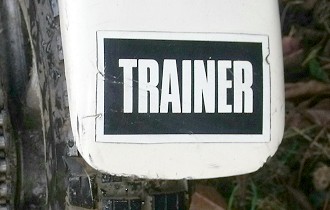
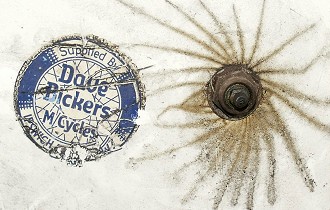
This new Mark 3 was so attractive because of the preserved detail of its remarkable originality, so this was a golden opportunity we absolutely weren’t going to pass on: the correct Haldo alloy wheels complete with Talon cable-operated disc rear brake, right down to the original tyres; its Union jack emblem transfers ‘John Louis Racing Ltd, TRAINER, Bury St. Edmunds 67951’ on the Cornish alloy tank; the fibreglass moulded primary chain-guard with cover sticker ‘Supplied by Dave Bickers M/cycles, Ipswich’; and ‘TRAINER’ decal on the fibreglass rear mudguard. So many features we’d not seen on our first example, and everything about this bike is so completely correct and untouched that it gives us a rare time-bubble insight to a totally original, locally built and locally sold machine.
In the interview with builder Peter Cornish, he reported that SIM bikes were typically built in batches to fit in between the commercial building equipment, generally employing a couple of fitters and, at peak assembly times, could reportedly have up to 10 operators working on their manufacture.
Features of the SIM continued to evolve with ongoing production, though there was no distinction between the introductions of specific changes to the Mark 2. The machine simply developed as a series of modifications came through, so a number of bikes can be identified progressively incorporating the various phases.
Changes to the SIM were as often driven by supply of materials as engineering initiatives, not least among such situations as running out of all suitable wheel component stock at Harris! To resolve the spoked wheels crisis, new alloy wheels were sand-cast by neighbouring Haldo Developments of Bury St. Edmunds, then finish-machined by Cornish themselves. While the front remained a brakeless wheel, the rear now sported SIM’s own 42-tooth sprocket and disc, with the cable-operated calliper bought-in from Talon Engineering. The cast aluminium wheels were smaller diameter than the preceding 12-inch Dunlop rims and, though fitted with slightly fatter 2.50 × 10 tyres, the outside diameter was reduced from 16 inches to 15 inches. This reduction in circumference technically dropped the final drive ratio by 6.5%, and was effectively compensated by two fewer teeth on the new 42-tooth rear sprocket (returning the ratio by 4.5%), so 2% ratio reduction to a sub-30mph bike represented barely ½mph, and of little real consequence since a SIM’s top speed was of no significance under the conditions it would generally be used.
It’s often presumed the later models utilised market standard alloy speedway tanks to further emulate the track bikes, but these were actually uniquely produced for the SIM, as Peter Cornish invested a great deal of time in personally making a press tool to form their own petrol tank halves from aluminium sheet, which were then welded together with all fittings, within the business.
Moulds were also created now to produce the chain-case, seat base, and rear mudguard in fibreglass and, checking it out, our bike does now have a fibreglass moulded seat base, replacing the steel pan of the Mark 2.
Handlebar clamps changed from the earlier alloy block types machined as numbered pairs, to a steel fabricated assembly. The stone guard clamped to the frame down-tube on this example is still an alloy plate, though of a lighter gauge than the Mark 2. The reduction drive shield is also still of lighter gauge aluminium plate than the Mark 2, and the inlet manifold appears to be made from two quarter-form curved pipes which have been welded in the middle—possibly an extension of the original Ariel-3 inlet manifold?
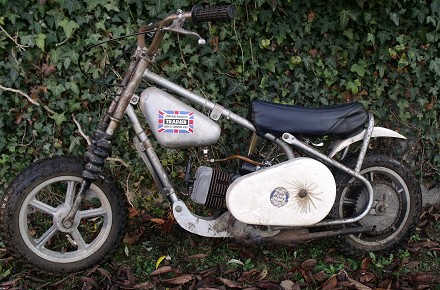
By the time the last changes to the frame and footrest assembly were in place, replacing the bottom tubes and adjustment brackets by an engine plate arrangement, and a different exhaust system that ran its pipe down between the engine plates and beneath the frame; so much had altered that the SIM-50 was a completely different bike and had effectively now entered what is considered its completed Mark 3 form.
The choke is now a rotary motor cycle lever, tucked away on a frame plate beneath the saddle. Pull the Ewarts plunger tap for fuel on, twist the throttle grip forward to decompress, then scoot the bike down the drive to get the engine spinning, and with your knee on the saddle stop the rear tyre slipping when you release the decompresser. Just turn on the throttle so Anker’s M-48 fires right up, and the automatic clutch takes over the moment it runs.
For smaller youngsters, it’s just as easy to ‘paddle’ the bike off—they quickly get the hang of a starting procedure.
The Encarwi S22 12mm carburettor is the same model fitted to the Ariel-3, and the exhaust gives out a pleasant flat burbling tone as we warm the motor and ease off the choke. Once the automatic clutch bites, torque from the reed-valve induction pulls the bike effectively on-throttle, accompanied by a deep and mellow roar from the exhaust, up to a top speed of just 18mph as the motor enters a rage of four-stroking which blusters its ability to gain further revs (a condition that can improve once the motor gets thoroughly hot, but we didn’t run it long enough to test that).
The top speed on a SIM-50 Trainer ‘Garden Bike’ isn’t particularly critical, considering the application and age group of its typical riders.
The freshly serviced Talon rear disc brake proved so effective that it could readily lock up the rear wheel on grass, and could single-handedly and very capably drag down the speed on a firmer service.
The SIM-50 was designed as a children’s bike, but is built strongly enough for any adult to ride, though being so small, this may not be easy, nor comfortable.
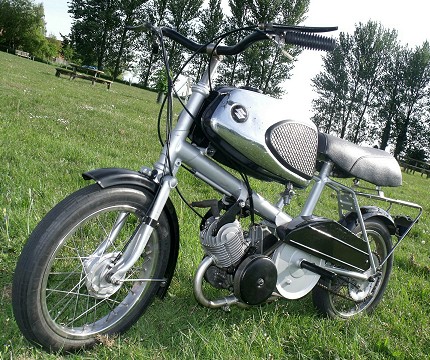
Where there are garden mini-bikes, there’s one particular home-made conversion that seems to keep popping up—further expanding beyond our ‘Afterlife’ feature in July 2010 on cut-down Wisps, we have another one.
This 1960s’ style road-bike ‘retro-classic’ came about in 2013 as the workshops built up the machine to clear a leftover selection of odd parts.
The primary Wisp components: frame, forks, wheels, and rear carrier frame, were residual parts that came among the earlier debris that produced ‘Old Yellow’ & ‘Dragon’ for the original Afterlife feature. Retro’s frame had already been very crudely cut-down in some much earlier and apparently unsuccessful attempt to produce a mini-bike, then the half-hearted project seemingly abandoned and long left to the fate of corrosion, which had taken its further toll on the cut tubes.
There was little prospect of this frame ever being reconstructed as an original Wisp again, so it was basically just a case of recycling what was already lost.
The already shortened saddle tube was reconstructed with a clamp top to re-mount a stem, and the remains of the rear stays folded over to be re-welded back lower on the saddle tube.
Using an old Suzuki Sportsman M15 fuel tank, tubular mounts were welded onto the Wisp frame to locate the tank in the desired position, and matched to an adapted Tomos saddle.
The current seat height is effectively fixed at 25 inches, and doesn’t allow for any practical adjustment.

Potential problems with the remains of Wisp’s low slung stand in off-road use were resolved by complete removal of the rest of the bracket, so there’s no concern about ground clearance, but it does mean that you have to resort to leaning the bike everywhere it stands.
With a lowered seat position, the original Wisp handlebars would become like a pair of ape-hangers, so a replacement Raleigh RM4 bar set brings the controls down to a sensible level. The handlebars are currently set at 32 inches height, but remaining capacity in the stem would probably allow these to go down as low as 30 inches.
The forks and both wheels are original Wisp, so this little bike has a pair of very effective hub brakes.
The rear mudguard too is Wisp, but was badly corroded in the rear portion, so this aft section was cut away just below the carrier frame and a strip welded to bolt up to the rear lamp mounting bracket of the carrier frame; not only giving a firm fixing point, but also neatly acting as a mud flap.
The front mudguard is converted from a Honda Express rear guard, and the belt/chain guard made from pieces of a scrap Phillips Panda side panel.
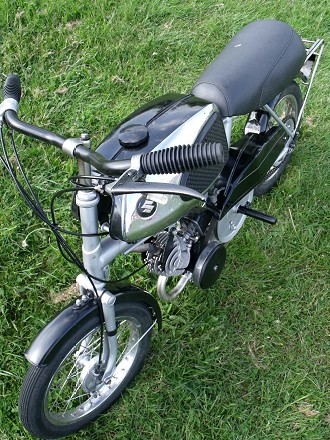
The motor is based on a 1.7bhp split-fin cylinder with slightly enlarged exhaust porting to discourage any four-stroking tendencies. Head compression has been slightly increased by planing back the face to take the ratio up to somewhere around 8.5:1. The Wisp inlet manifold is opened out to 10.5mm bore (original size was 9mm) but, instead of the Gurtner AR10 carburettor, is fitted with an earlier Gurtner BA10—just because that’s what was readily available. Power output is probably slightly up on the original engine specification, but the changes are mainly intended to improve the bike’s pull-off abilities since it no longer has pedals to assist the initial phase.
The rear wheel is still fitted with the original 44-tooth sprocket, but a reduced 11-tooth front drive sprocket (standard specification is 12-tooth) at the belt flywheel, so the transmission ratio is reduced by 8% for better pull off abilities.
The bike was intended to look retro-sporty, and tweaks to the motor with alterations to the drive ratio were meant to make it go a little better, without making it too fast.
With the complete pedalling set removed, it’s now down to push starting, and tube-type footrests are mounted on the flywheel shaft. The original Suzuki lever fuel tap with gravity filter bowl switches off–on–reserve.
Since the throttle set is taken from a Mobylette 51V, decompression is worked by a thumb trigger below the twistgrip, scoot forward, and the engine readily spins, turn back the throttle and thumb the choke trigger below the left lever and the motor fires up right away with a blustering tone from the Brevette exhaust.
Considering all the removed components in producing one of these cut-down machines, all up weight is now down to just 4st 10lb (30kg), and the low drive ratio allows the motor easily to pull even an adult away from a standstill without any pedalling requirement. With the higher compression ratio and reduced gearing, acceleration is pretty brisk, and the modified exhaust porting allows revs to pick up without any four-stroke phasing, so this tiny bike readily gets up to a top speed around 23–24mph, at which the motor is revving angrily, and the noisy exhaust roaring quite loudly.
This seems quite fast enough on such a small machine, and really feels like the bike is giving its all.
Due to the advantages afforded from the physics of having small wheels, both brakes prove very effective.
Despite the increasing popularity of more modern Oriental-built children’s pit bikes with clutch, gears, and appreciably more power, the cut-down Wisps still have their place. They’re simple, practical, cheap and durable—and do seem to outlast their modern counterparts, which have established a reputation for breaking rather easily.
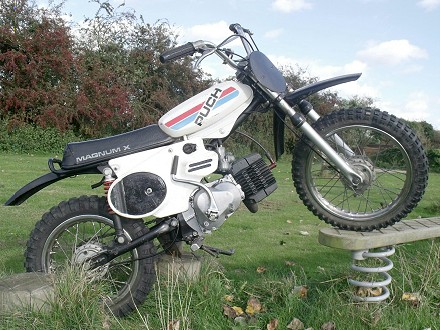
The commercially-produced Woodhouse Cornish SIM-50 was joined by other makes of children’s bikes in 1978 as Puch introduced its Magnum X, and NVT brought out the Ranger.
Puch introduced its little off-road mini-bike to Britain in 1978 and, though new to the UK, it had already been selling in other markets for a while.
The Puch Magnum X children’s off-road dirt bike had been on sale in America since 1974, but just to confuse things slightly, this wasn’t the only Magnum. There were also road-going full-size mopeds called Magnum XK (automatic) and Magnum Mark II with a two-speed ZA50 motor, but these models weren’t sold in the UK. The ‘Magnum’ designation seems to have been applied to Maxi-based ‘sports’ models, then the type further identified by the suffix.
The North American market for off-road mini-motor cycles would seem to have been perceived as being well ahead of the UK’s youngsters, and this British market really only started to establish following introduction of the SIM-50 from October 1974.
The Puch engine is based on an E50 Maxi block, with the usual automatic clutch and single speed drive, but a kick-starter mechanism instead of the typical period pedal drive arrangement of the road-going mopeds. Comparing the Magnum X to an E50 Maxi, anyone can be forgiven for thinking they seem like completely different motors, but you have to look a little closer to see the tricks. The Magnum frame covers quite a large portion of the rear engine casing so you only really notice the kick-start casing on the right, and flywheel cover on the left.
Peek underneath the engine and sure enough, there’s the Maxi stand bracket on the bottom of the casting, then you can also see the engine is more suitably mounted for off-road use to present the cylinder at an upward angle, instead of horizontal on the street-going Maxi.
The top end assembly is different, but also not new, since Magnum mounts the big-fin, air-cooled type head and barrel from the VZ Sport.
The kick-starter case was initially introduced for the Magnum E50 variant, but subsequently became employed on Maxi models as various countries redefined their moped definitions to not requiring pedals in the later 1970s, so much the only part remaining unique to the Magnum is the curly inlet manifold to the 17mm Bing carburettor.
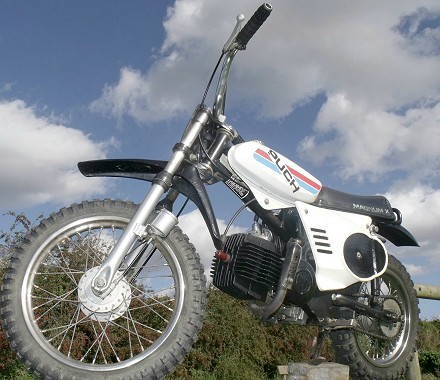
Comparative UK market Maxi motors were specified at 2.2bhp with the centre-plug cylinder head and 14mm carburettor, but some feeling that the automatic Magnum X may require more power for its off-road application resulted in its upgraded motor being rated at a very creditable 3.5bhp, making this the most powerful automatic motor that Puch ever made.
The Magnum stator set is not equipped with a lighting coil, since the off-road application requires no lights. The only electrical circuit as such, is a grounding wire for the ignition system, to a kill switch on the handlebars.
The cycle chassis looks a proper 1970s’ style miniature scrambler: telescopic forks, swinging arm rear suspension, with a 40-inch wheelbase and a 24-inch saddle height. The knobbly tyres are also in character: 3.00 × 12 on the rear and 2.50 × 14 up front, with chrome rims spoked onto cast alloy conical hubs with cooling rings set around the brake band—these really do look the part!
The petrol tank is steel, while plastic moulded trims cover the main body and include plates for fitting race numbers. The side panels cover the air intake, filter and HT coil on the right, and pan type silencer to the left, which exits through a tailpipe from under the seat. Take a closer look at that flat silencer box, and it might seem familiar … yes, that’s an MS50 box laid sideways—clever old Puch!
Ahead of the steering head the upper forks are trimmed by a front race plate. The front and rear guards are moulded plastic then, getting down to the nitty-gritty, off-road style folding steel foot pegs and a ‘chip shop side stand’ that no longer stands, because some schoolboy has probably posed on it once too often.
Also mimicking a typical 1970s’ trials fashion, is a little 45mph VDO moped speedometer, low-mounted off the left-hand fork leg with only a 6-inch cable from the drive, and yes, that is also original fitting.
There are a lot of nice touches that show Puch was really thinking about getting the Magnum X detail right for the time. In its day, this must have been the aspirational machine of every potential schoolboy scrambler … but it also cost a lot of money.
Farmers Weekly magazine dated 13th July 1979 commented, ‘At £277, very few parents will be able to afford to give their children the ultimate present’.
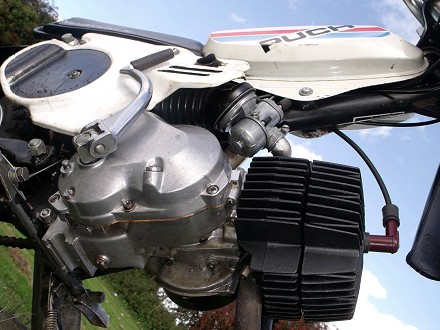
Our Magnum X has obviously experienced a fair bit of use in its time, but is still an original and representative example.
Starting is fairly similar to a kick-start Maxi. The petrol tap comprises a dial switch through the right-hand side panel; push down the choke shutter rod on the top of the carburetter, which will progressively lift off as the throttle is opened, so generally works better if you resist the urge to twist the grip until the motor has fired up. When nothing seems to have happened after a few kicks, we try clicking the unmarked kill switch to the other position, which achieves the desired result, and ease in the throttle to clear the choke.
Sit down on the bike, and the saddle does seem a long way down, and the rear suspension seems to settle rather a lot too—which immediately serves to convince that this machine really isn’t intended for a full sized adult … then we notice a decal on the tank top ‘WARNING—single rider only, weight limit 98lbs’. That’s what? 7 stone … Ah! That’ll be the problem then!
Wind open the throttle and there’s more noisy induction roar than exhaust tone, with lots of busy revs while the automatic clutch slips in the initial phase as Magnum smartly picks up speed. The auto clutch bites around 10mph+ at which acceleration suddenly feels more progressive. With the motor revs topping out, our pace bike tracked the top speed at 28mph. Magnum can easily get to this top speed at pretty much any suitable opportunity since the off-road gearing is quite low. Its acceleration is appreciably quicker than the Maxi moped, and some parents might even have been alarmed at how fast the Magnum could be, but this higher power would also be giving the automatic clutch a hiding.
When it comes down to quite what you’re supposed to be able to do with Magnum X, this is not so clear. Because of the automatic clutch we don’t feel you can actually use it like a trials bike, since this requires torque and a positive gear. Neither does the auto drive deliver the kind of usable power required to qualify as a scrambler, so really it’s another ‘round-in-circles’ garden track bike rather like the SIM-50.
Brakes were good; handling seemed a little light at the front, though someone unkindly suggested this may not have been helped by the test rider being a few extra pounds over the prescribed weight limit, so we presume a lighter jockey might find this more satisfactory.
The Magnum X was reportedly only re-listed in its original style for 1979, then re-titled of sorts into the 1980s with Puch ‘Turbo’ on the tank and ‘Rough Rider’ printed on the seat, but there was no real technical difference.
The NVT Ranger was also re-branded and titled as the BSA Junior from August 1979.
With other major manufacturers and various Italian brands joining in sales of children’s motor cycles, it was now becoming quite apparent that mini-bikes were being considered a serious commercial proposition.
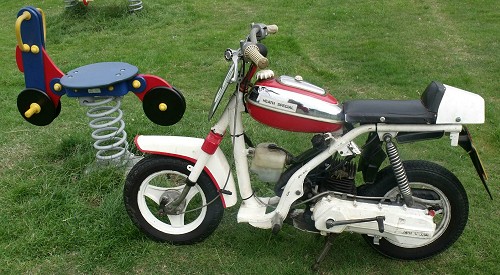
Even though a number of makes of commercially built children’s mini-bikes were now becoming readily available in the 1980s, this didn’t mean that home-built ingenuity was a thing of the past. Beyond the Raleigh Wisp, there could be other suitable machines with small wheels.
The Heath Minibike is a one-off special, built by Neville Heath for his grandchildren. A basket-case Yamaha Passola donated most of the components, but its scooter frame would have proved too large for purpose, so basically had the middle cut out between the engine and headstock down-tube. The two ends were welded back together by a connection plate, then the headstock braced by a square top-tube welded back to the rear frame, and straddled by a Puch petrol tank. A pair of rigid foot pegs was then welded to the frame beside the connection plate.
The result gives reduction to a 37-inch wheelbase and total length of just 52 inches nose-to-tail. The rear frame rails are made over with a home-fashioned ‘fastback’ seat, for a pad height of 24 inches.
The Heath retains the Yamaha engine, 50cc with a two-speed automatic transmission and auto-lubrication, where the oil reservoir is relocated to fill the space in front of the engine. While the position probably isn’t the most stylish for this cloudy plastic tank, it’s very practical to keep an eye on the oil level, and is tucked safely out of the way in the event of a spill.
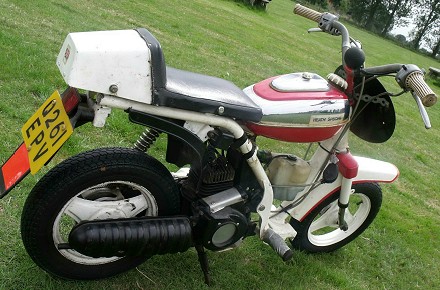
Following failure of the original vacuum tap components, a simplified fuel cock now turns on by an indicated lever at the back left of the petrol tank. A former light switch on the right handlebar cluster now functions as ignition cut-out, click from ‘off’ to ‘on’. There doesn’t appear to be any effective choke mechanism, so pinching up the rubber pipe from the air filter to the carburetter intake may provide a similar enriching effect. Following a number of encouraging jabs at the kick-starter (a typically horrible scooter-style, rear set, left-handed kick-lever, but you can at least boot it over with your right foot by standing off the bike), nipping the intake pipe, and twisting open and closing the throttle, suddenly the motor fires and we’re ready to go. Despite the lack of choke, once the motor is running, it ticks over right away without stalling.
Still equipped with a standard qualifying and road legal silencer system, the exhaust note is harmlessly stifled and pleasantly quiet enough to hardly disturb anyone.
The seating position isn’t ideal for a full sized adult, as the handlebars pass over your knees fairly closely, but the bike is still quite manageable once you adapt.
The two-speed auto drive provides ample acceleration in first ratio up to 14mph, where it surges into second and carries the Heath up to a paced 31mph. While we’re giving the Heath Minibike big handfuls of throttle to thrash it up to speed on our limited length test track, our following pace bike rider (since our Heath has no speedometer), describes the billowing clouds of smoke ‘as smelling like burning tyres’ … we figure the oil pump metering maybe set a little rich, but no, the stream of smoke really does prove to be the contents of the exhaust on fire!
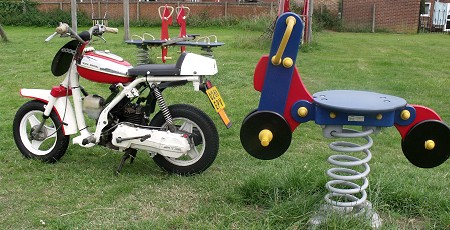
The bike still delivers much the same performance as the original Passola scooter and, to be honest, that is probably more go than the machine really needs in a capacity as a garden bike—but that’s not exactly its limitation, since the Heath is also road registered!
No, it’s not still pretending to be the Passola it once was, since the donor remains came with no number or documents. Having built the bike, its owner decided it would be quite a novelty to have the bike registered with ‘Heath’ as the make, and a local authority official came round to examine the machine and approve the application.
The minibike was daylight MoT’d (no lights), taxed, and legally road registered by its builder on 3rd July 1990, with the vehicle ‘make’ being recorded as ‘Heath’, which technically renders it the last official motor cycle made in Ipswich!
The frame number is stamped and recorded as 1990/NH001, and issued by Ipswich Authority with a local PV series Q-plate registration under the note ‘assembled from parts, some or all of which not being new’.
The original Passola suspension is retained at both ends: short telescopic fork set, and single sided rear spring. Suspension operation proves particularly bouncy at both front and rear with an adult aboard, so we presume the front springs may have gone soft and the rear unit is no longer damping effectively—probably two decades of being tracked around the garden has taken its toll.
The Heath really was used on public roads up until expiry of its last tax and MoT in June 1991, since which time it’s been relegated to ‘garden duties’ for a succession of eight grandchildren, and is now seeing further service by another generation of great grandchildren!

